The Importance of Higher Education in the EU Countries in Achieving the Objectives of the Circular Economy in the Energy Sector
Abstract
1. Introduction
2. Aim and Methods
3. Results and Discussion
4. Conclusions
Author Contributions
Funding
Conflicts of Interest
References
- Jurgilevich, A.; Birge, T.; Kentala-Lehtonen, J.; Korhonen-Kurki, K.; Pietikäinen, J.; Saikku, L.; Schösler, H. Transition towards circular economy in the food system. Sustainability 2016, 8, 69. [Google Scholar] [CrossRef]
- Lieder, M.; Rashid, A. Towards circular economy implementation: A comprehensive review in context of manufacturing industry. J. Clean. Prod. 2015, 115, 36–51. [Google Scholar] [CrossRef]
- Geissdoerfer, M.; Savaget, P.; Bocken, N.M.; Hultink, E.J. The Circular Economy—A new sustainability paradigm? J. Clean. Prod. 2017, 143, 757–768. [Google Scholar] [CrossRef]
- Pomponi, F.; Moncaster, A. Circular economy research in the built environment: A theoretical contribution. In Building Information Modelling, Building Performance, Design and Smart Construction; Dastbaz, M., Gorse, C., Eds.; Springer: Cham, Switzerland, 2016. [Google Scholar]
- Zink, T.; Geyer, R. Circular economy rebound. J. Ind. Ecol. 2017, 21, 593–602. [Google Scholar] [CrossRef]
- Korhonen, J.; Honkasalo, A.; Seppälä, J. Circular economy: The concept and its limitations. Ecol. Econ. 2018, 143, 37–46. [Google Scholar] [CrossRef]
- Korhonen, J.; Nuur, C.; Feldmann, A.; Birkie, S.E. Circular economy as an essentially contested concept. J. Clean. Prod. 2018, 175, 544–552. [Google Scholar] [CrossRef]
- Prieto-Sandoval, V.; Jaca, C.; Ormazabal, M. Towards a consensus on the circular economy. J. Clean. Prod. 2018, 179, 605–615. [Google Scholar] [CrossRef]
- Morseletto, P. Targets for a circular economy. Resour. Conserv. Recycl. 2020, 153, 104553. [Google Scholar] [CrossRef]
- Stahel, W.R.; Reday-Mulvey, G. Jobs for Tomorrow: The Potential for Substituting Manpower for Energy; Vantage Press: New York, NY, USA, 1981. [Google Scholar]
- Schulenburg, J.M.; Giarini, O.; Stahel, W.R. The Limits to Certainty. Facing Risks in the New Service Economy (Book Review). J. Econ. 1990, 52, 95. [Google Scholar]
- Stahel, W.R. Resource-miser business models. Int. J. Environ. Technol. Manag. 2007, 7, 483–495. [Google Scholar] [CrossRef]
- Bocken, N.M.; De Pauw, I.; Bakker, C.; Van Der Grinten, B. Product design and business model strategies for a circular economy. J. Ind. Prod. Eng. 2016, 33, 308–320. [Google Scholar] [CrossRef]
- Blomsma, F.; Brennan, G. The emergence of circular economy: A new framing around prolonging resource productivity. J. Ind. Ecol. 2017, 21, 603–614. [Google Scholar] [CrossRef]
- European Union: EU Commission. Closing the Loop—An Eu Action Plan for the Circular Economy; Communication from the Commission to the European Parliament, the Council, the European Economic and Social Committee and the Committee of the Regions COM (2015) 614/2; European Union: Brussels, Belgium, 2015. [Google Scholar]
- European Union: European Commission. Communication from the Commission to the European Parliament, the Council, the European Economic and Social Committee and the Committee of the Regions on a Monitoring Framework for the Circular Economy; COM (2018) 29 Final; European Union: Brussels, Belgium, 2018. [Google Scholar]
- Gregson, N.; Crang, M.; Fuller, S.; Holmes, H. Interrogating the circular economy: The moral economy of resource recovery in the EU. Econ. Soc. 2015, 44, 218–243. [Google Scholar] [CrossRef]
- Kirchherr, J.; Piscicelli, L.; Bour, R.; Kostense-Smit, E.; Muller, J.; Huibrechtse-Truijens, A.; Hekkert, M. Barriers to the circular economy: Evidence from the European Union (EU). Ecol. Econ. 2018, 150, 264–272. [Google Scholar] [CrossRef]
- Cheng, M. Sharing economy: A review and agenda for future research. Int. J. Hosp. Manag. 2016, 57, 60–70. [Google Scholar] [CrossRef]
- Ghisellini, P.; Cialani, C.; Ulgiati, S. A review on circular economy: The expected transition to a balanced interplay of environmental and economic systems. J. Clean. Prod. 2016, 114, 11–32. [Google Scholar] [CrossRef]
- Lewandowski, M. Designing the business models for circular economy—Towards the conceptual framework. Sustainability 2016, 8, 43. [Google Scholar] [CrossRef]
- Sauvé, S.; Bernard, S.; Sloan, P. Environmental sciences, sustainable development and circular economy: Alternative concepts for trans-disciplinary research. Environ. Dev. 2016, 17, 48–56. [Google Scholar] [CrossRef]
- Elia, V.; Gnoni, M.G.; Tornese, F. Measuring circular economy strategies through index methods: A critical analysis. J. Clean. Prod. 2017, 142, 2741–2751. [Google Scholar] [CrossRef]
- Godelnik, R. Millennials and the sharing economy: Lessons from a ‘buy nothing new, share everything month’project. Environ. Innov. Soc. Transit. 2017, 23, 40–52. [Google Scholar] [CrossRef]
- Kirchherr, J.; Reike, D.; Hekkert, M. Conceptualizing the circular economy: An analysis of 114 definitions. Resour. Conserv. Recycl. 2017, 127, 221–232. [Google Scholar] [CrossRef]
- Murray, A.; Skene, K.; Haynes, K. The circular economy: An interdisciplinary exploration of the concept and application in a global context. J. Bus. Ethics 2017, 140, 369–380. [Google Scholar] [CrossRef]
- Weber, G.; Cabras, I. The transition of Germany’s energy production, green economy, low-carbon economy, socio-environmental conflicts, and equitable society. J. Clean. Prod. 2017, 167, 1222–1231. [Google Scholar] [CrossRef]
- Hens, L.; Block, C.; Cabello-Eras, J.J.; Sagastume-Gutierez, A.; Garcia-Lorenzo, D.; Chamorro, C.; Vandecasteele, C. On the evolution of “Cleaner Production” as a concept and a practice. J. Clean. Prod. 2018, 172, 3323–3333. [Google Scholar] [CrossRef]
- Philippidis, G.; Bartelings, H.; Helming, J.; M’barek, R.; Smeets, E.; Van Meijl, H. The good, the bad and the uncertain: Bioenergy use in the European Union. Energies 2018, 11, 2703. [Google Scholar] [CrossRef]
- Van Meijl, H.; Tsiropoulos, I.; Bartelings, H.; Hoefnagels, R.; Smeets, E.; Tabeau, A.; Faaij, A. On the macro-economic impact of bioenergy and biochemicals–Introducing advanced bioeconomy sectors into an economic modelling framework with a case study for the Netherlands. Biomass Bioenergy 2018, 108, 381–397. [Google Scholar] [CrossRef]
- Wang, J.; Yang, Y.; Bentley, Y.; Geng, X.; Liu, X. Sustainability assessment of bioenergy from a global perspective: A review. Sustainability 2018, 10, 2739. [Google Scholar] [CrossRef]
- Ubando, A.T.; Felix, C.B.; Chen, W.H. Biorefineries in circular bioeconomy: A comprehensive review. Bioresour. Technol. 2020, 299, 122585. [Google Scholar] [CrossRef]
- Geng, Y.; Doberstein, B. Developing the circular economy in China: Challenges and opportunities for achieving’leapfrog development’. Int. J. Sustain. Dev. World Ecol. 2008, 15, 231–239. [Google Scholar] [CrossRef]
- Mathews, J.A.; Tan, H. Progress toward a circular economy in China: The drivers (and inhibitors) of eco-industrial initiative. J. Ind. Ecol. 2011, 15, 435–457. [Google Scholar] [CrossRef]
- Geng, Y.; Fu, J.; Sarkis, J.; Xue, B. Towards a national circular economy indicator system in China: An evaluation and critical analysis. J. Clean. Prod. 2012, 23, 216–224. [Google Scholar] [CrossRef]
- Williams, E.; Kahhat, R.; Bengtsson, M.; Hayashi, S.; Hotta, Y.; Totoki, Y. Linking informal and formal electronics recycling via an interface organization. Challenges 2013, 4, 136–153. [Google Scholar] [CrossRef]
- Gu, Y.; Wu, Y.; Xu, M.; Wang, H.; Zuo, T. The stability and profitability of the informal WEEE collector in developing countries: A case study of China. Resour. Conserv. Recycl. 2016, 107, 18–26. [Google Scholar] [CrossRef]
- Petit-Boix, A.; Leipold, S. Circular economy in cities: Reviewing how environmental research aligns with local practices. J. Clean. Prod. 2018, 195, 1270–1281. [Google Scholar] [CrossRef]
- Liakos, N.; Kumar, V.; Pongsakornrungsilp, S.; Garza-Reyes, J.A.; Gupta, B.; Pongsakornrungsilp, P. Understanding circular economy awareness and practices in manufacturing firms. J. Enterp. Inf. Manag. 2019, 32, 563–584. [Google Scholar] [CrossRef]
- Ngan, S.L.; How, B.S.; Teng, S.Y.; Promentilla, M.A.B.; Yatim, P.; Er, A.C.; Lam, H.L. Prioritization of sustainability indicators for promoting the circular economy: The case of developing countries. Renew. Sustain. Energy Rev. 2019, 111, 314–331. [Google Scholar] [CrossRef]
- Virtanen, M.; Manskinen, K.; Uusitalo, V.; Syvänne, J.; Cura, K. Regional material flow tools to promote circular economy. J. Clean. Prod. 2019, 235, 1020–1025. [Google Scholar] [CrossRef]
- Fonseca, L.M.; Domingues, J.P.; Pereira, M.T.; Martins, F.F.; Zimon, D. Assessment of Circular Economy within Portuguese Organizations. Sustainability 2018, 10, 2521. [Google Scholar] [CrossRef]
- Stahel, W.R. The circular economy. Nature 2016, 531, 435–438. [Google Scholar] [CrossRef]
- Kılkış, Ş.; Kılkış, B. Integrated circular economy and education model to address aspects of an energy-water-food nexus in a dairy facility and local contexts. J. Clean. Prod. 2017, 167, 1084–1098. [Google Scholar] [CrossRef]
- Pomponi, F.; Moncaster, A. Circular economy for the built environment: A research framework. J. Clean. Prod. 2017, 143, 710–718. [Google Scholar] [CrossRef]
- Merli, R.; Preziosi, M.; Acampora, A. How do scholars approach the circular economy? A systematic literature review. J. Clean. Prod. 2018, 178, 703–722. [Google Scholar] [CrossRef]
- Kirchherr, J.; Piscicelli, L. Towards an education for the circular economy (ECE): Five teaching principles and a case study. Resour. Conserv. Recycl. 2019, 150, 104406. [Google Scholar] [CrossRef]
- Fonseca, L.M.; Portela, A.R.; Duarte, B.; Queirós, J.; Paiva, L. Mapping higher education for sustainable development in Portugal. Manag. Mark. Chall. Knowl. Soc. 2018, 13, 1064–1075. [Google Scholar] [CrossRef]
- Dixon, P.M.; Weiner, J.; Mitchell-Olds, T.; Woodley, R. Erratum to ’Bootstrapping the Gini Coefficient of Inequality. Ecology 1988, 69, 1307. [Google Scholar] [CrossRef]
- Dagum, C. The Generation and Distribution of Income, the Lorenz Curve and the Gini Ratio. Econ. Appliquée 1980, 33, 327–367. [Google Scholar]
- Starzyńska, W. Statystyka Praktyczna; Wydawnictwo Naukowe PWN: Warszawa, Poland, 2002; p. 102. [Google Scholar]
- Abdi, H. Coefficient of variation. Encycl. Res. Des. 2010, 1, 169–171. [Google Scholar]
- Jajuga, K.; Walesiak, M. Remarks on the Dependence Measures and the Distance Measures. In Klasyfikacja i Analiza Danych-Teoria i Zastosowania; Jajuga, K., Walesiak, M., Eds.; Prace Naukowe Akademii Ekonomicznej we Wrocławiu nr 1022; AE: Wrocław, Poland, 2004; pp. 348–354. [Google Scholar]
- Atkinson, A.B. The Economics of Inequality; Clarendon Press: Oxford, UK, 1983; pp. 46–59. [Google Scholar]
- Lorenz, M.O. Methods of Measuring the Concentration of Wealth. Publ. Am. Stat. Assoc. 1905, 9, 209–219. Available online: https://www.jstor.org/stable/2276207 (accessed on 10 July 2020). [CrossRef]
- Hauke, J.; Kossowski, T. Comparison of Values of Pearson’s and Spearman’s Correlation Coefficients on the Same Sets of Data. Quaest. Geogr. 2011, 30, 87–93. [Google Scholar] [CrossRef]
- Pandey, N.; Vedak, V. Structural transformation of education for sustainable development. Int. J. Environ. Sustain. Dev. 2010, 9, 3–15. [Google Scholar] [CrossRef]
- Berryman, T.; Sauvé, L. Ruling relationships in sustainable development and education for sustainable development. J. Environ. Educ. 2016, 47, 104–117. [Google Scholar] [CrossRef]
- Mendoza, J.M.F.; Gallego-Schmid, A.; Azapagic, A. Building a business case for implementation of a circular economy in higher education institutions. J. Clean. Prod. 2019, 220, 553–567. [Google Scholar] [CrossRef]
- Zografakis, N.; Menegaki, A.N.; Tsagarakis, K.P. Effective education for energy efficiency. Energy Policy 2008, 36, 3226–3232. [Google Scholar] [CrossRef]
- Kopnina, H. Circular economy and Cradle to Cradle in educational practice. J. Integr. Environ. Sci. 2018, 15, 119–134. [Google Scholar] [CrossRef]
- Kopnina, H. Green-washing or best case practices? Using circular economy and Cradle to Cradle case studies in business education. J. Clean. Prod. 2019, 219, 613–621. [Google Scholar] [CrossRef]
- Colombo, E.; Mattarolo, L. Energy and development: The role of academia in education, research, and technological cooperation for sustainability. Wiley Interdiscip. Rev. Energy Environ. 2017, 6, e215. [Google Scholar] [CrossRef]
- João, I.M.; Silva, J.M. Sustainable product design education: Engineering students’ perceptions and attitudes. In Proceedings of the 2020 IEEE Global Engineering Education Conference (EDUCON), Porto, Portugal, 27–30 April 2020; pp. 150–157. [Google Scholar]
- Connor, A.; Karmokar, S.; Whittington, C. From STEM to STEAM: Strategies for enhancing engineering & technology education. Int. J. Eng. Pedagog. 2015, 5, 37–47. [Google Scholar]
- Lucas, B.; Hanson, J. Thinking like an engineer: Using engineering habits of mind and signature pedagogies to redesign engineering education. Int. J. Eng. Pedagog. 2016, 6, 4–13. [Google Scholar] [CrossRef]
- Whalen, K.A.; Berlin, C.; Ekberg, J.; Barletta, I.; Hammersberg, P. ‘All they do is win’: Lessons learned from use of a serious game for Circular Economy education. Resour. Conserv. Recycl. 2018, 135, 335–345. [Google Scholar] [CrossRef]
- Admiraal, W.; Post, L.; Guo, P.; Saab, N.; Makinen, S.; Rainio, O.; Danford, G. Students as future workers: Cross-border multidisciplinary learning labs in higher education. Int. J. Technol. Educ. Sci. 2019, 3, 85–94. [Google Scholar]
- Clauss-Ehlers, C.S.; Parham, W.D. Landscape of diversity in higher education: Linking demographic shifts to contemporary university and college counseling center practices. J. Multicult. Couns. Dev. 2014, 42, 69–76. [Google Scholar] [CrossRef]
- Mizikaci, F.; Baumgartl, B. Demographic trends and risks for European higher education. Int. Higher Educ. 2007, 47, 15–16. [Google Scholar] [CrossRef]
- Nellis, J.G.; Nellis, H.G.; Slattery, D. The challenges and prospects for higher education in the context of global change. Int. J. Econ. Bus. Res. 2013, 5, 347–361. [Google Scholar] [CrossRef]
- Arlett, C.; Lamb, F.; Dales, R.; Willis, L.; Hurdle, E. Meeting the needs of industry: The drivers for change in engineering education. Eng. Educ. 2010, 5, 18–25. [Google Scholar] [CrossRef]
- Dean, S.; Hopkins, A. Aspects of mutual engagement: School of engineering and industry collaborations. Higher Educ. Pedagog. 2016, 1, 30–41. [Google Scholar]
- Janicki, T.N.; Cummings, J. Increasing Student/Corporate Engagement. Inf. Syst. Educ. J. 2017, 15, 37. [Google Scholar]
- Acikgoz, C. Renewable energy education in Turkey. Renew. Energy 2011, 36, 608–611. [Google Scholar] [CrossRef]
- Karabulut, A.; Gedik, E.; Keçebaş, A.; Alkan, M.A. An investigation on renewable energy education at the university level in Turkey. Renew. Energy 2011, 36, 1293–1297. [Google Scholar] [CrossRef]
- Qu, M.; Ahponen, P.; Tahvanainen, L.; Gritten, D.; Mola-Yudego, B.; Pelkonen, P. Chinese university students’ knowledge and attitudes regarding forest bio-energy. Renew. Sustain. Energy Rev. 2011, 15, 3649–3657. [Google Scholar] [CrossRef]
- Zyadin, A.; Puhakka, A.; Ahponen, P.; Cronberg, T.; Pelkonen, P. School students’ knowledge, perceptions, and attitudes toward renewable energy in Jordan. Renew. Energy 2012, 45, 78–85. [Google Scholar] [CrossRef]
- Mälkki, H.; Alanne, K.; Hirsto, L. A method to quantify the integration of renewable energy and sustainability in energy degree programmes: A Finnish case study. J. Clean. Prod. 2015, 106, 239–246. [Google Scholar] [CrossRef]
- Sucic, B.; Lah, P.; Visocnik, B.P. An education and training program for energy managers in Slovenia–Current status, lessons learned and future challenges. J. Clean. Prod. 2017, 142, 3360–3369. [Google Scholar] [CrossRef]
- Perkins, J.H.; Middlecamp, C.; Blockstein, D.; Cole, J.R.; Knapp, R.H.; Saul, K.M.; Vincent, S. Energy education and the dilemma of mitigating climate change. J. Environ. Stud. Sci. 2014, 4, 354–359. [Google Scholar] [CrossRef]
- Figueiró, P.S.; Raufflet, E. Sustainability in higher education: A systematic review with focus on management education. J. Clean. Prod. 2015, 106, 22–33. [Google Scholar] [CrossRef]
- Dlouhá, J.; Glavič, P.; Barton, A. Higher education in Central European countries–Critical factors for sustainability transition. J. Clean. Prod. 2017, 151, 670–684. [Google Scholar] [CrossRef]
- Ruiz-Rivas, U.; Martinez-Crespo, J.; del Carmen Venegas-Bernal, M.; Chinchilla-Sanchez, M. Energy engineering curricula for sustainable development, considering underserved areas. J. Clean. Prod. 2020, 258, 120960. [Google Scholar] [CrossRef]
- Klein, G.A.; Hoffman, R.R. Seeing the invisible: Perceptual-cognitive aspects of expertise. Cogn. Sci. Found. Instr. 1993, 203–226. Available online: https://cmapspublic3.ihmc.us/rid=1G9NSY15K-N7MJMZ-LC5/SeeingTheInvisible.pdf (accessed on 10 July 2020).
- Mihelcic, J.R.; Crittenden, J.C.; Small, M.J.; Shonnard, D.R.; Hokanson, D.R.; Zhang, Q.; Schnoor, J.L. Sustainability science and engineering: The emergence of a new metadiscipline. Environ. Sci. Technol. 2003, 37, 5314–5324. [Google Scholar] [CrossRef]
- Jennings, P. New directions in renewable energy education. Renew. Energy 2009, 34, 435–439. [Google Scholar] [CrossRef]
- Batterman, S.A.; Martins, A.G.; Antunes, C.H.; Freire, F.; da Silva, M.G. Development and application of competencies for graduate programs in energy and sustainability. J. Prof. Issues Eng. Educ. Pract. 2011, 137, 198–207. [Google Scholar] [CrossRef]
- Guinee, J.B.; Heijungs, R.; Huppes, G.; Zamagni, A.; Masoni, P.; Buonamici, R.; Rydberg, T. Life cycle assessment: Past, present, and future. Environ. Sci. Technol. 2011, 45, 90–96. [Google Scholar] [CrossRef] [PubMed]
- Malkki, H.; Alanne, K.; Hirsto, L. Energy engineering students on their way to expertise in sustainable energy. Environ. Clim. Technol. 2012, 8, 24–28. [Google Scholar] [CrossRef]
- Gelegenis, J.J.; Harris, D.J. Undergraduate studies in energy education—A comparative study of Greek and British courses. Renew. Energy 2014, 62, 349–352. [Google Scholar] [CrossRef]
- Harris, D.J.; Gelegenis, J.J. Energy engineering: An emerging discipline. In Engineering Education. Curriculum, Pedagogy and Didactic Aspects; Oxford University Press: Oxford, UK, 2014; pp. 145–163. [Google Scholar]
- Nowotny, J.; Dodson, J.; Fiechter, S.; Gür, T.M.; Kennedy, B.; Macyk, W.; Rahman, K.A. Towards global sustainability: Education on environmentally clean energy technologies. Renew. Sustain. Energy Rev. 2018, 81, 2541–2551. [Google Scholar] [CrossRef]
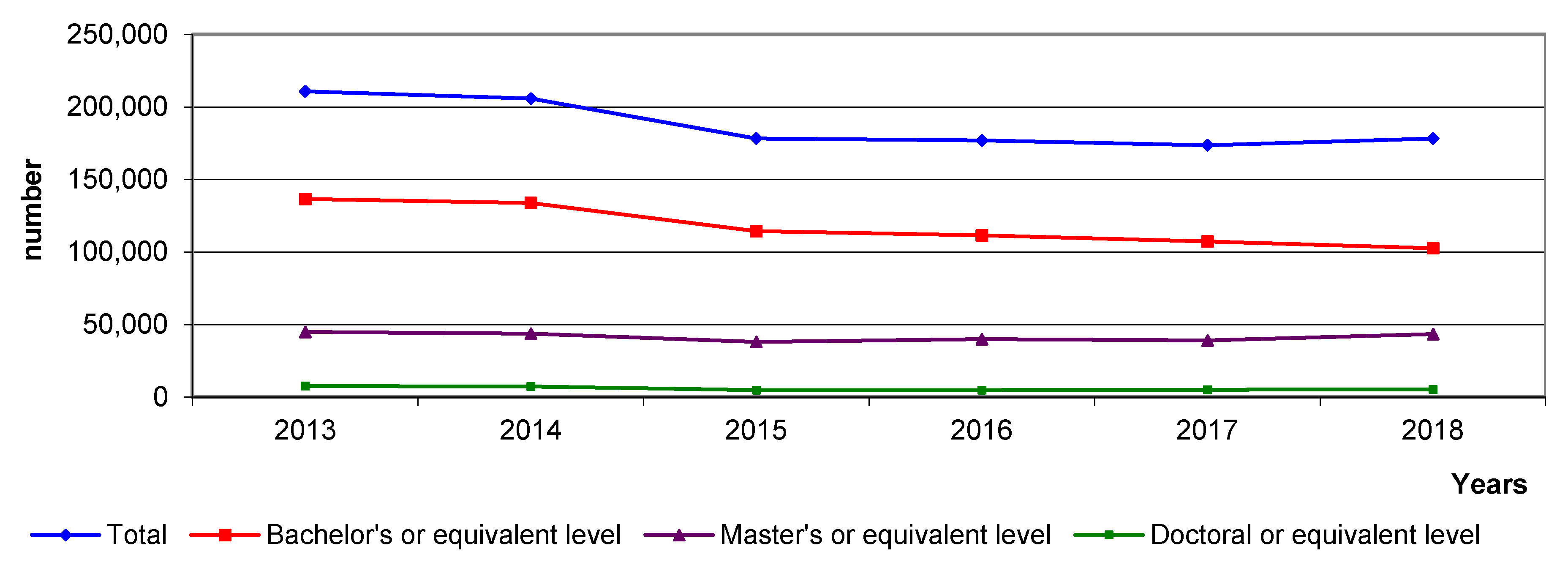
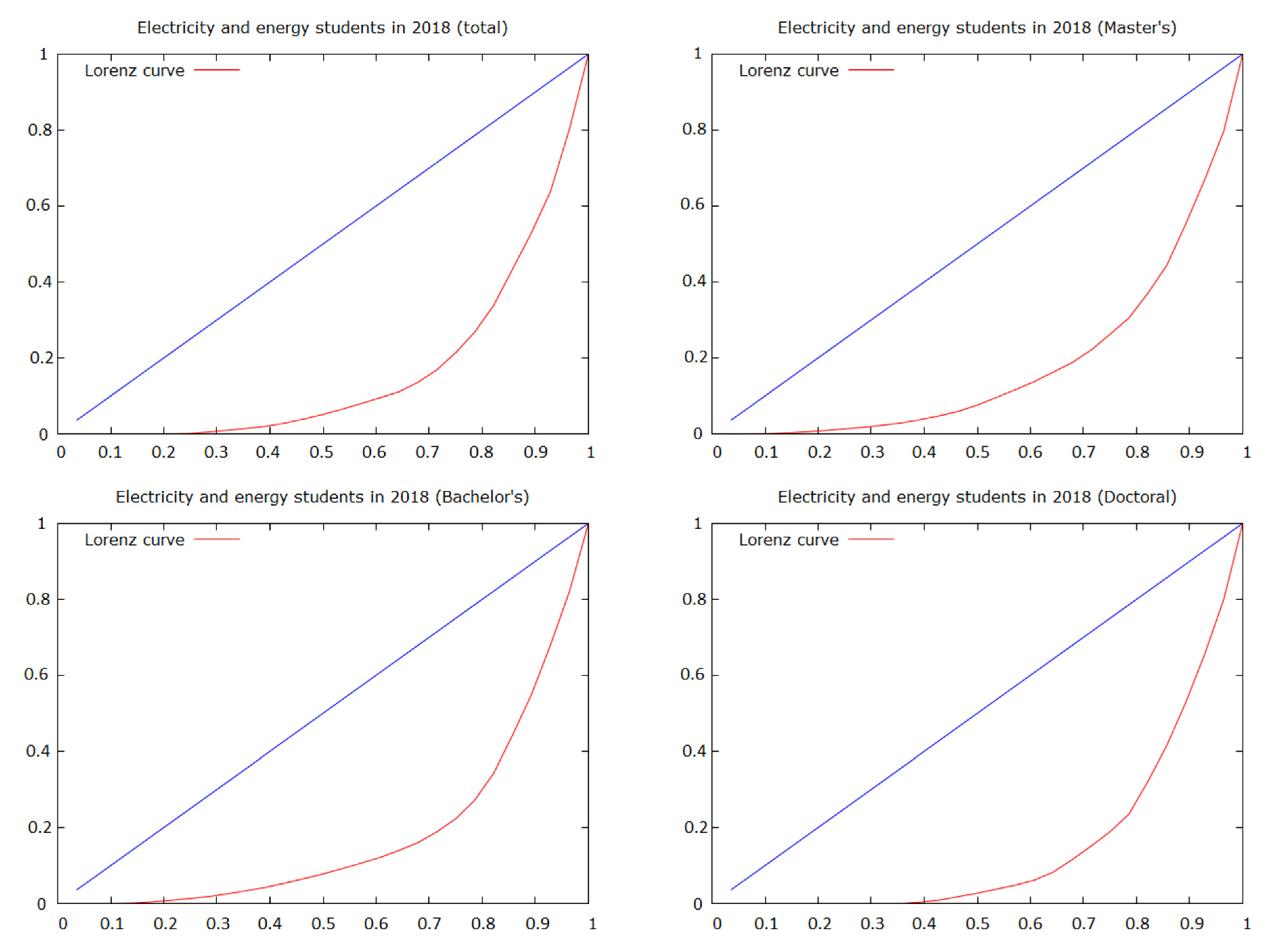
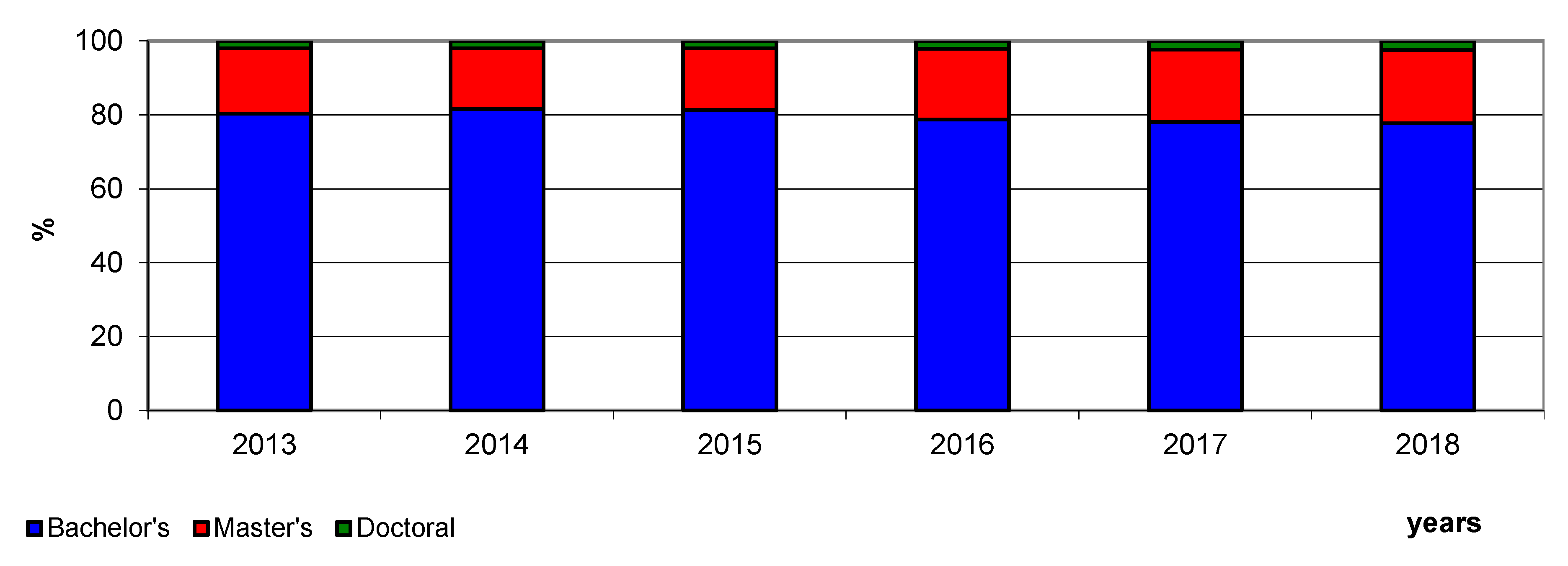
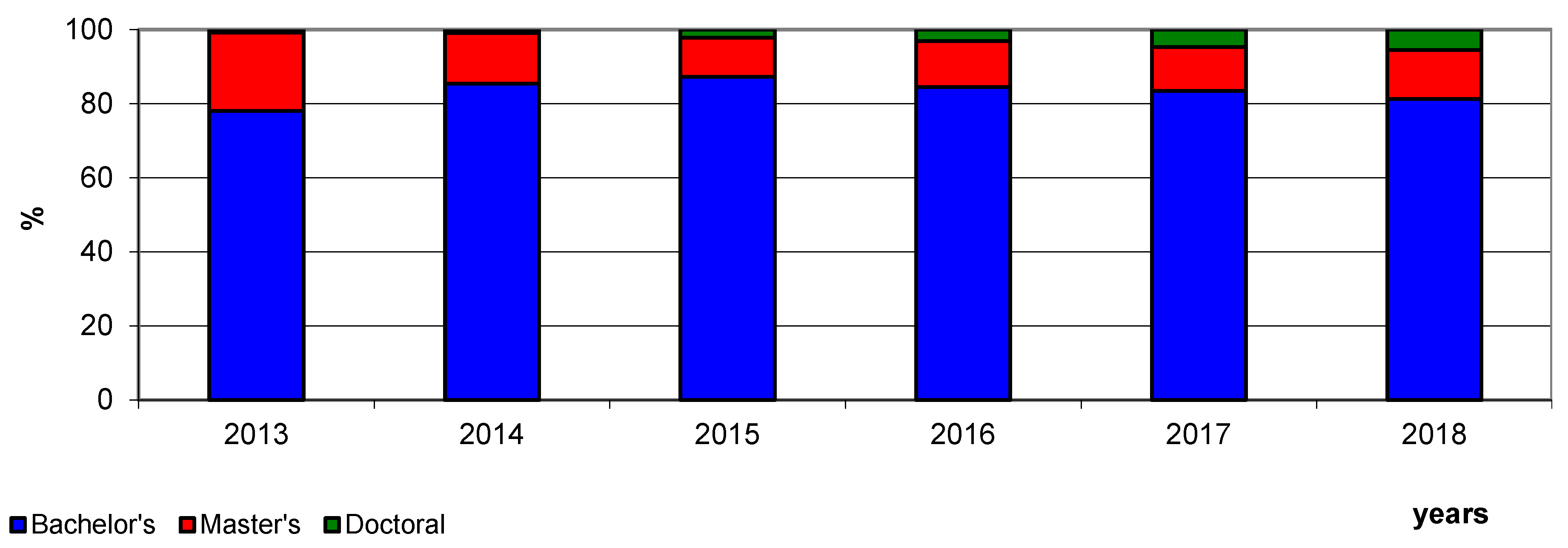
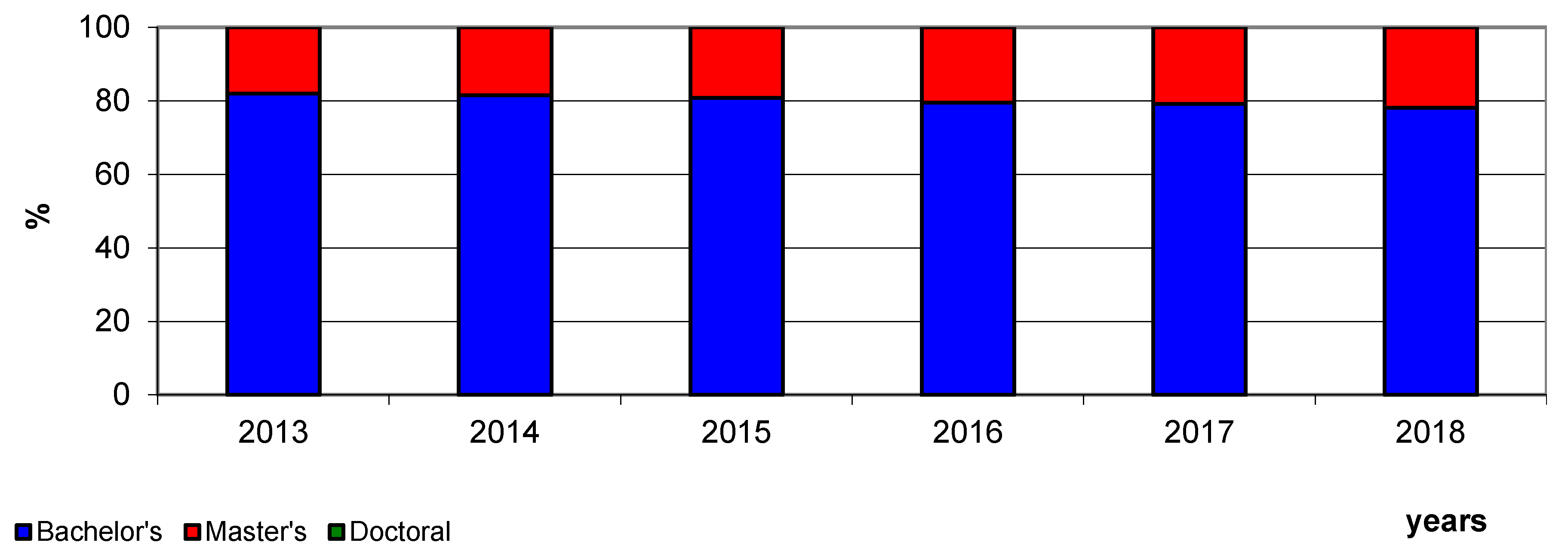
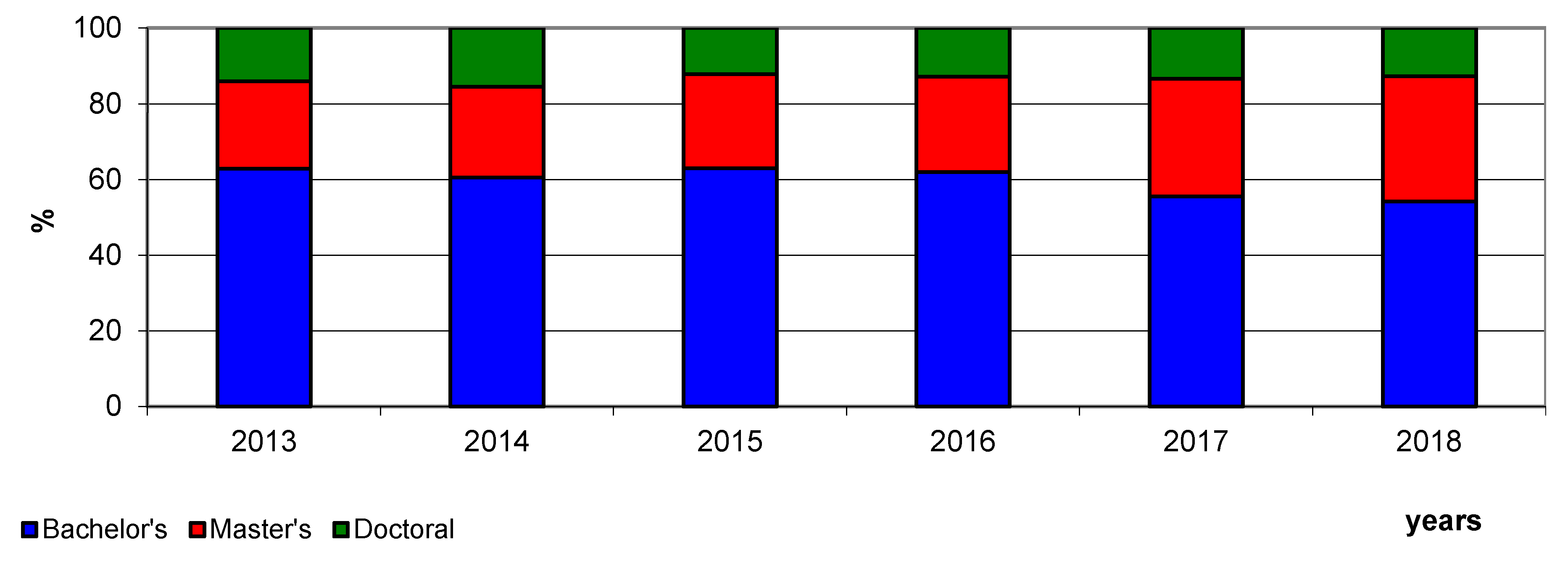
| Educational Levels | Gini Coefficients in Years | |||
|---|---|---|---|---|
| 2013 | 2018 | |||
| From Sample | Estimated | From Sample | Estimated | |
| Total | 0.66 | 0.69 | 0.68 | 0.70 |
| Bachelor’s | 0.65 | 0.67 | 0.64 | 0.67 |
| Master’s | 0.58 | 0.60 | 0.63 | 0.66 |
| Doctoral | 0.69 | 0.71 | 0.70 | 0.73 |
| Countries | Dynamics Indicators for Education Levels in 2013–2018 | |||
|---|---|---|---|---|
| Total | Bachelor’s | Master’s | Doctoral | |
| France | 162.61 | 135.77 | 202.85 | 98.47 |
| Denmark | 139.73 | 173.84 | 248.24 | - |
| Italy | 135.36 | - | 135.43 | - |
| Netherlands | 119.15 | 113.50 | 144.86 | - |
| Cyprus | 110.52 | 98.74 | 91.12 | 85.19 |
| Finland | 108.20 | 102.08 | 160.93 | 92.94 |
| Croatia | 98.85 | 108.73 | 87.20 | 0.00 |
| Sweden | 98.84 | 104.29 | 115.94 | 102.11 |
| Germany | 98.77 | 87.87 | 154.01 | - |
| Latvia | 98.21 | 99.10 | 85.53 | 95.77 |
| Austria | 93.23 | 95.67 | 98.11 | 88.45 |
| Malta | 90.99 | 127.94 | 58.33 | - |
| Poland | 89.53 | 84.90 | 98.32 | 107.27 |
| EU | 84.53 | 75.08 | 96.63 | 69.59 |
| Belgium | 79.57 | 83.63 | 70.28 | 123.74 |
| Bulgaria | 73.29 | 73.69 | 71.83 | 74.83 |
| Spain | 71.04 | 74.12 | 44.49 | 499.34 |
| Hungary | 68.28 | 69.52 | 98.73 | 100.00 |
| Ireland | 68.11 | 204.55 | 70.65 | - |
| Portugal | 67.86 | 52.47 | 75.43 | 84.16 |
| Luxembourg | 67.35 | 40.82 | - | - |
| Slovenia | 62.39 | 76.03 | 31.71 | 42.22 |
| Greece | 60.31 | 62.08 | 77.21 | - |
| Lithuania | 58.58 | 56.30 | 68.48 | 82.86 |
| Estonia | 53.08 | 47.27 | 67.52 | 74.32 |
| Romania | 51.60 | 59.42 | 35.72 | 44.66 |
| Slovakia | 34.04 | 29.72 | 45.08 | 29.35 |
| Czechia | 19.86 | 17.14 | 28.31 | 18.09 |
| United Kingdom | - | - | - | - |
| Countries | Coefficients of Variation for the Number of Students by Education Level | |||
|---|---|---|---|---|
| Total | Bachelor’s | Master’s | Doctoral | |
| Latvia | 0.02 | 0.04 | 0.09 | 0.07 |
| Austria | 0.03 | 0.06 | 0.10 | 0.04 |
| Finland | 0.04 | 0.04 | 0.17 | 0.03 |
| EU | 0.04 | 0.11 | 0.06 | 0.20 |
| Cyprus | 0.09 | 0.10 | 0.12 | 0.16 |
| Denmark | 0.11 | 0.18 | 0.32 | - |
| Bulgaria | 0.12 | 0.11 | 0.15 | 0.13 |
| Luxembourg | 0.12 | 0.32 | 0.73 | - |
| Spain | 0.12 | 0.10 | 0.40 | 0.57 |
| Ireland | 0.13 | 0.32 | 0.18 | - |
| Portugal | 0.14 | 0.24 | 0.09 | 0.10 |
| Hungary | 0.14 | 0.13 | 0.03 | 0.08 |
| Belgium | 0.15 | 0.21 | 0.15 | 0.46 |
| Lithuania | 0.16 | 0.18 | 0.13 | 0.10 |
| Malta | 0.17 | 0.17 | 0.26 | 2.24 |
| France | 0.20 | 0.16 | 0.23 | 0.04 |
| Estonia | 0.24 | 0.28 | 0.17 | 0.14 |
| Greece | 0.29 | 0.27 | 0.36 | 1.42 |
| Romania | 0.32 | 0.23 | 0.52 | 0.53 |
| Slovakia | 0.47 | 0.63 | 0.28 | 0.48 |
| Croatia | 0.71 | 0.04 | 0.06 | 0.77 |
| Poland | 0.71 | 0.07 | 0.07 | 0.05 |
| Czechia | 0.76 | 0.78 | 0.67 | 0.82 |
| Slovenia | 1.01 | 0.11 | 0.42 | 0.33 |
| Italy | 2.24 | 1.12 | 0.10 | - |
| Netherlands | 2.24 | 0.04 | 0.13 | - |
| Germany | - | 0.06 | 0.14 | - |
| Sweden | - | 0.03 | - | 0.02 |
| United Kingdom | - | - | - | - |
| Tested Parameters | Pearson’s Linear Correlation Coefficients | |||||||
|---|---|---|---|---|---|---|---|---|
| Total | Bachelor’s | Master’s | Doctoral | |||||
| r | p-Value | r | p-Value | r | p-Value | r | p-Value | |
| Energy productivity (Euro per kilogram of oil equivalent) | −0.052 | 0.503 | −0.133 | 0.086 | 0.009 | 0.908 | −0.205 | 0.008 |
| Share of renewable energy in gross final energy consumption (total) | −0.001 | 0.990 | −0.057 | 0.463 | 0.055 | 0.479 | 0.280 | 0.001 |
| Share of renewable energy in gross final energy consumption in transport | 0.091 | 0.241 | −0.049 | 0.528 | 0.223 | 0.004 | 0.343 | 0.001 |
| Share of renewable energy in gross final energy consumption in electricity | 0.078 | 0.315 | 0.007 | 0.928 | 0.123 | 0.112 | 0.165 | 0.033 |
| Share of renewable energy in gross final energy consumption in heating and cooling | −0.102 | 0.188 | −0.117 | 0.131 | −0.076 | 0.327 | 0.195 | 0.011 |
| Greenhouse gas emissions intensity of energy consumption | 0.020 | 0.797 | 0.130 | 0.093 | −0.030 | 0.699 | −0.189 | 0.014 |
| Final energy consumption in households per capita | −0.082 | 0.291 | −0.152 | 0.049 | −0.010 | 0.898 | 0.161 | 0.037 |
© 2020 by the authors. Licensee MDPI, Basel, Switzerland. This article is an open access article distributed under the terms and conditions of the Creative Commons Attribution (CC BY) license (http://creativecommons.org/licenses/by/4.0/).
Share and Cite
Rokicki, T.; Perkowska, A.; Klepacki, B.; Szczepaniuk, H.; Szczepaniuk, E.K.; Bereziński, S.; Ziółkowska, P. The Importance of Higher Education in the EU Countries in Achieving the Objectives of the Circular Economy in the Energy Sector. Energies 2020, 13, 4407. https://doi.org/10.3390/en13174407
Rokicki T, Perkowska A, Klepacki B, Szczepaniuk H, Szczepaniuk EK, Bereziński S, Ziółkowska P. The Importance of Higher Education in the EU Countries in Achieving the Objectives of the Circular Economy in the Energy Sector. Energies. 2020; 13(17):4407. https://doi.org/10.3390/en13174407
Chicago/Turabian StyleRokicki, Tomasz, Aleksandra Perkowska, Bogdan Klepacki, Hubert Szczepaniuk, Edyta Karolina Szczepaniuk, Stanisław Bereziński, and Paulina Ziółkowska. 2020. "The Importance of Higher Education in the EU Countries in Achieving the Objectives of the Circular Economy in the Energy Sector" Energies 13, no. 17: 4407. https://doi.org/10.3390/en13174407
APA StyleRokicki, T., Perkowska, A., Klepacki, B., Szczepaniuk, H., Szczepaniuk, E. K., Bereziński, S., & Ziółkowska, P. (2020). The Importance of Higher Education in the EU Countries in Achieving the Objectives of the Circular Economy in the Energy Sector. Energies, 13(17), 4407. https://doi.org/10.3390/en13174407







